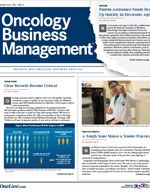Dipping a Toe Into Care Management
Fee-for-service remains the primary driver of patient revenue for the majority of oncology practices across the country, and the same is true for The Center for Cancer and Blood Disorders.
David Wheeler, CPA, MBA
The Center for Cancer and Blood Disorders began to wade into the waters of care management when it joined the Come Home project, along with six other cancer practices, several years ago. In participating, we began thinking of how patient care would be delivered in the near future. The entirety of our operations would need to be evaluated and a different means of delivering care would come from this endeavor.
Fee-for-service remains the primary driver of patient revenue for the majority of oncology practices across the country, and the same is true for us. The Come Home project became more about managing patients from the perspective of keeping them out of the emergency department and managing them from the outset of the initial visit through to posttreatment aftercare. These primary focal points of the Come Home project would be addressed in several different ways: patient navigation, case management, and triage.
Triage Nurses Make a Difference
The Center had begun to use patient navigators prior to the Come Home project to assist our patients through the continuum of care, so we were experienced in this regard for the portion of the Come Home project that required patient navigators. The primary role of patient navigators is to assist our patients through the process of treatment such as appointment setting, going over our documents, giving reassurance, and assisting with any questions our patients may have. It is another layer of personalized care for our patients to get them through the gantlet of cancer care, which can be overwhelming and confusing.Another component that we added was centralized triage nurses. This was a big change for our practice as this had never been a component of our care. We found this to be a great service for our patients and providers, as well. The triage nurses assisted in many of the calls to resolve issues before our patients’ calls went to our providers or they assisted in getting our patients to our main clinic if needed. In many instances, our patients would have gone to the emergency department, thus impacting the cost curve for CMS. Triage nurses became a welcome tool for the practice and one that continued subsequent to the Come Home project.
Another important addition to our practice was case managers. I would say they worked well and hand-in-hand with the triage nurses. The case managers take a more long-term approach to patient care than do the triage nurses. Whereas the triage nurses are dealing with current issues, the case managers are dealing with longer-term issues that will affect our patients’ care. Again, each function is concerned with more appropriate care and cost savings, which will be the focus of more payer programs such as Come Home. The services that the case managers performed were either over the phone or in person when patients were seen at our primary office. It is important to note that this position still exists in our practice.
As a financial person, I was concerned about the overall cost of adding these positions. However, even after the completion of the project, many of the processes are still active today and the cost commitment on our part has paid for itself. Just the experience of the project has been of immeasurable value from an operational perspective. Most important, it has been wonderful for our patients. They are the reason we, at The Center, do what we do. In addition, the Come Home experience afforded us the opportunity to be ahead of the curve in participating in the Oncology Care Model.




